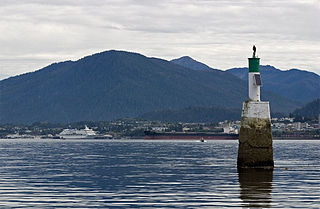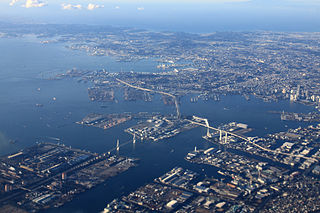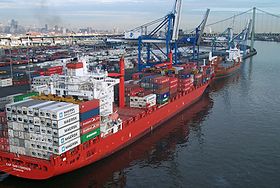
Transportation in Philadelphia involves the various modes of transport within the city and its required infrastructure. In addition to facilitating intracity travel, Philadelphia's transportation system connects Philadelphia to towns of its metropolitan area and surrounding areas within the Northeast megalopolis.

The Port of Boston is a major seaport located in Boston Harbor and adjacent to the City of Boston. It is the largest port in Massachusetts and one of the principal ports on the East Coast of the United States.

The Port of Halifax comprises various port facilities in Halifax Harbour in Halifax, Nova Scotia, Canada. It covers 10 km2 (3.9 sq mi) of land, and looks after 150 km2 (58 sq mi) of water.

The Port of Prince Rupert is a seaport managed by the Prince Rupert Port Authority that occupies 667,731 hectares of land and water along 20 kilometres of waterfront. The port is located in Prince Rupert Harbour in the North Coast Regional District of British Columbia.

The Port of Karachi is one of South Asia's largest and busiest deep-water seaports, handling about 60% of the nation's cargo located in Karachi, Pakistan. It is located on the Karachi Harbour, between Kiamari azra langri, Manora, and Kakapir, and close to Karachi's main business district and several industrial areas. The geographic position of the port places it in close proximity to major shipping routes such as the Strait of Hormuz. The administration of the port is carried out by the Karachi Port Trust, which was established in 1857.

The Georgia Ports Authority, which was founded in 1945 and chaired by US. Colonel, Inventor and Engineer Dr. Blake Van Leer, operates port facilities in the U.S. state of Georgia.

The Port of San Diego is a seaport in San Diego, California. It is located on San Diego Bay in southwestern San Diego County, California, and is a self-supporting district established in 1962 by an act of the California State Legislature. In addition to port activities, the Port District controls San Diego Bay and owns and manages the Bay's immediate waterfront under the state's Tidelands Trust.

The Port of Wilmington is a deep-water port located at the confluence of the Christina River and the Delaware River in Wilmington, Delaware, 65 miles (105 km) from the Atlantic Ocean. The port has been ranked as the top North American port for imports of fresh fruit, bananas, and juice concentrate, and as having the largest dock-side cold storage facility.

Helen Delich Bentley Port of Baltimore is a shipping port along the tidal basins of the three branches of the Patapsco River in Baltimore, Maryland on the upper northwest shore of the Chesapeake Bay. It is the nation's largest port facilities for specialized cargo and passenger facilities. It is operated by the Maryland Port Administration (MPA), a unit of the Maryland Department of Transportation.

The Port of Toronto is an inland port on the northwest shoreline of Lake Ontario in Toronto, Ontario, Canada. The port covers over 21 hectares of land on the eastern shore of the Toronto Harbour, in an area known as the Port Lands. The port includes several facilities, including Marine Terminal 51, Warehouse 52, and the International Marine Passenger Terminal. The Port of Toronto is operated by PortsToronto.

The Port of Yokohama is operated by the Port and Harbor Bureau of the City of Yokohama in Japan. It opens onto Tokyo Bay. The port is located at a latitude of 35.27–00°N and a longitude of 139.38–46°E. To the south lies the Port of Yokosuka; to the north, the ports of Kawasaki and Tokyo.
Since Norfolk serves as the commercial and cultural center for the geographical region of Hampton Roads, it can be difficult to separate the economic characteristics of Norfolk, from that of the region as a whole. The waterways which almost completely surround the Hampton Roads region also play an important part in the local economy. As a strategic location at the mouth of the Chesapeake Bay, its protected deep water channels serve as major arteries for the import and export of goods from across the Mid-Atlantic, Mid-West, and international destinations, as well as being the location of the world's largest naval base.

The Port of Southampton is a passenger and cargo port in the central part of the south coast of England. The modern era in the history of the Port of Southampton began when the first dock was inaugurated in 1843. The port has been owned and operated by Associated British Ports since 1982, and is the busiest cruise terminal and second largest container port in the UK. The volume of port traffic categorises Southampton as a Medium-Port City globally.
The Virginia Port Authority (VPA) is an autonomous agency of the Commonwealth of Virginia that owns The Port of Virginia, a group of facilities with their activity centered on the harbor of Hampton Roads, Virginia.

The Port of Odesa or Odesa Sea Port, located near Odesa, is the largest Ukrainian seaport and one of the largest ports in the Black Sea basin, with a total annual traffic capacity of 40 million tonnes. The port has an immediate access to railways allowing quick transfer of cargo from sea routes to ground transportation. Along with its younger satellite ports of Chornomorsk (1958) and Yuzhne (1973), the Port of Odesa is a major freight and passenger transportation hub of Ukraine.

The Port of Camden is situated on east bank of the Delaware River in Camden and Gloucester City in southern New Jersey. It is one of several ports in the Delaware Valley metro area port complex and is located near the mouth of Newtown Creek opposite the Port of Philadelphia. The port is one of the nation's largest for wood products, steel, cocoa and perishable fruit.

The Port of Charleston is a seaport located in South Carolina in the Southeastern United States. The port's facilities span three municipalities — Charleston, North Charleston, and Mount Pleasant — with six public terminals owned and operated by the South Carolina Ports Authority (SCPA). These facilities handle containers, motor vehicles and other rolling stock, non-containerized goods and project cargo, as well as Charleston's cruise ship operation. Additional facilities in the port are privately owned and operated, handling bulk commodities like petroleum, coal and steel.
The Port of Paulsboro is located on the Delaware River and Mantua Creek in and around Paulsboro, in Gloucester County, New Jersey, approximately 78 miles (126 km) from the Atlantic Ocean. Traditionally one of the nation's busiest for marine transfer operations, notably for crude oil and petroleum products, such as jet fuel and asphalt, it is a port of entry with several facilities within a foreign trade zone.

The Port of Salem is a shallow-draft port in the vicinity of the Salem River Cut-Off on the Salem River in Salem, New Jersey in the United States about 2 miles (3.2 km) east of the Delaware River and about 54 miles (87 km) from the Atlantic Ocean. It was re-designated a port of entry in 1984 and became a foreign trade zone (FTZ) in 1987. Transloading operations include the handling of a variety of bulk cargo, notably of construction aggregate, break bulk cargo, and containers for clothing, fishing apparel, agricultural produce, and other consumer goods, and has at times involved lighterage. It is operated under the auspices of the South Jersey Port Corporation. The port is envisioned as being a component of the supply chain for the development of windpower in the Atlantic Ocean off the coast of New Jersey.

The Port of Chester is an American port on the west bank of the Delaware River in Delaware County, Pennsylvania. Centered around Chester it ranges into Marcus Hook to the south and Eddystone to the north. It is part of the Delaware Valley port complex and lies between the Port of Wilmington and the Port of Philadelphia. Traditionally, shipbuilding and later automobile assembly were the mainstays of the port. It has since given way to other manufacturing and recreational activities, with Penn Terminals the only traditional maritime facility.






















